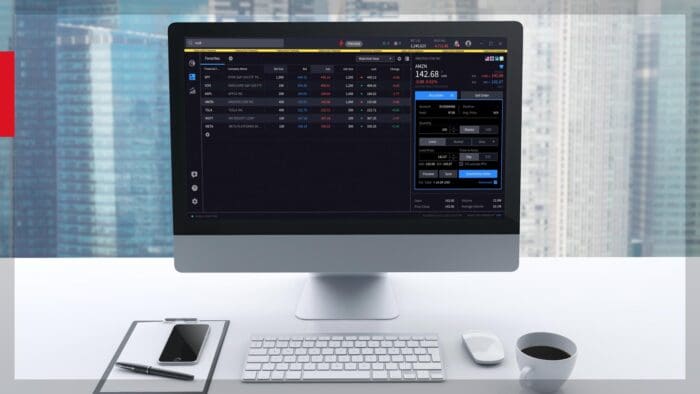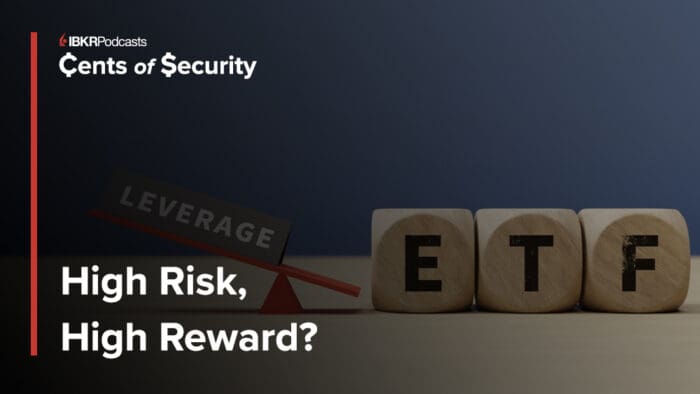In this episode we explore leveraged and inverse ETFs. They have many details associated that are a bit different than a standard stock or ETF investment. These include complexity, amplification of investment, and specific risks associated. We hope our listeners can learn more about their qualities and how they could be integrated into achieving financial goals. Edward Egilinsky, Managing Director at Direxion joins Cassidy Clement to discuss.
Summary – Cents of Security Podcasts Ep. 85
The following is a summary of a live audio recording and may contain errors in spelling or grammar. Although IBKR has edited for clarity no material changes have been made.
Cassidy Clement:
Welcome back to the Cents of Security podcast. I’m Cassidy Clement, Senior Manager of SEO and Content here at Interactive Brokers and today I’m your host for the podcast. Our guest is Ed Egilinsky, Managing Director and Head of Sales of Global Distribution and Alternatives at Direxion.
In this episode, we explore leveraged and inverse ETFs. They have many details associated and they’re a bit different than a standard stock or ETF investment. There’s many aspects of complexity, amplification of investments, and specific risks associated. So today we’re trying to have a conversation that will help our listeners learn more about the qualities of this investment and how they could be integrated into their plans towards their financial goals. Welcome to the program Ed.
Edward Egilinsky:
Thanks for having me.
Cassidy Clement:
Sure. So as this is your first episode on Cents of Security, why don’t you yourself a little bit to our listeners, maybe a little bit of background of how you got started in the industry.
Edward Egilinsky:
I know it’s hard to believe based on my hairline, but I’ve been in the business for 30 years in the financial industry. I’ve held various senior roles in sales and strategy. My expertise has been in alternative investments or alternative strategies. And for those viewers, I define alternative investments as areas like hedge funds, private equity, commodities, that don’t necessarily correlate or have a relationship to traditional stocks and bonds. Uh, and also they provide additional diversification within a portfolio. I’ve been at Direxion, for over 13 years and I’m the Head of Global Sales and Alternatives for the organization. And a little background on Direxion, we’ve been in business 25 plus years, primarily as an exchange traded fund provider, and we’ve been ranked amongst the top 20 in terms of US based ETF firms based on assets. Now exchange traded funds, what are the ETFs? They trade like stocks, but usually consists of a basket of either stocks or bonds. Now our expertise is specializing in leveraged and inverse ETFs, and we’ll touch on that in a minute.
Cassidy Clement:
Yeah, you sound like the perfect person to go into all of the aspects of leveraged and inverse ETFs today. So, as you kind of got into it, there’s obviously the core piece, which is what is an ETF? And then there’s all these additional branches, if you will, on that tree of what that. product is. So when we’re talking about leveraged and inverse ETF, it sounds like there’s a little bit of an explanation in the name, but what exactly are they and how would you explain them to more of a beginner investor?
Edward Egilinsky:
It’s a good question. Now, I think the easiest way to explain it is that we provide magnified daily returns of an underlying index sector, or in some cases, single stock, minus fund fees and expenses. These are trading tools and they’re designed to express short term trading views, whether bullish, if you think the market’s going up, that’s a bull fund, or a bear fund or an inverse fund, if you think the market’s going down. Within our Direxion lineup, the leverage points can range from a non-leveraged inverse bear fund to 3x bull and bear funds. But I just want to preface for beginners, this may not be appropriate for them because these are trading tools,
Cassidy Clement:
Yeah and I think for some people getting into the space, this is probably a little bit more of a discovery podcast or maybe even a refresher podcast if you will, if you’re a little more of an intermediate investor. To kind of understand what exactly these products are if you come across them in your reading or maybe in a financial strategy. So you had mentioned that this is kind of deriving its value from somewhere else or a other strategy and then amplifying itself because of the way that it’s structured. So how exactly would they differ from a regular ETF? As we all know an ETF is made up of several different things, but there may not be that amplification factor or that impact inverse factor.
Edward Egilinsky:
Correct. So we employ leverage, different leverage points, let’s say on the S&P 500, and we have 2 and 3X leverage products in the S&P 500. These are high risk reward vehicles, and as I mentioned, they’re designed for tactical short term trading and these are for active traders that monitor their positions on a daily basis. These are not buy and hold vehicles. And leverage and inverse ETFs are what’s called path dependent. The trend is your We’ll track for any given single day, then there’ll be what’s called compounding when you trade these beyond one day and leverage can work for or against you.
So let me take a simple two day example: let’s say you own a 3X bull fund of the S&P 500, and you start with $100. And on the first day of trading, the S&P 500 is up 5%, so your $100 goes to $115. But unfortunately on day two, the S&P 500 goes down 5%. So you lose the 3X, let’s say it’s a 3X bull fund, 15 percent that second day. After two days, because of compounding, you’re below your initial $100 investment. So that’s where compounding can work against you when you’re basically up one day and down the next day, the same amount. But because of compounding after two days, you’re below your initial investment. Very important to understand. The flip side is, how does leverage work for you? Well, in that 3x bull fund, let’s say of the S&P 500, the first day the S&P 500 is up 5 percent again, in our example, and your 100 goes to $115, but this time on day two, you’re lucky enough, the trend continues. S&P 500 is up another 5%, so it’s a 3x fund, so you made 15 percent on day two. You’re actually above $130 after two days, because of the positive impact in this case of compounding, because the trend is working in your favor.
Cassidy Clement:
So based on a lot of what you’re saying, you know, it definitely sounds like you need to be that of more of an active trader where you’re watching the fund and watching the trends because it’s not meant to be some type of hold and wait type of investment. While you might be looking ahead to your positions or amplify your gains, or maybe it’s more of a speculative thing for you, the risks associated are very high if you’re not very much so paying attention and also very much so informed. And that may be elements of an advanced trader or maybe somebody who works with a financial advisor. So that leads me into my next question, which is this type of investment, while it sounds very layered and complex, are they for certain types of strategies or certain types of portfolios or is it more like anybody can kind of utilize them, but sometimes you do tend to see the more institutions or vice versa?
Edward Egilinsky:
Well, we have a lot of sophisticated retail, like a lot of your audience, in addition to institutional clients, which is some of your audiences as well, that are utilizing our tools. Now, these are trades, they’re not investments. So, they’re meant for those, traders who have conviction on short term direction of the market or single stock, whether it’s up or down. And they’re really used to try to enhance returns by taking on more risk. Now, these are packaged as ETFs, so you don’t need to have margin to obtain the leverage. It’s packaged within the ETF, where also your liability is limited to your initial investment. And for most of you out there that would like to take a short position periodically, whether it’s an individual stock, whether it’s on the S&P 500, very difficult to execute that but through an inverse ETF or a bear ETF, here’s your ability to express a short term view if you’re negative on the market or a single stock. So here’s a way to participate again where your liability is limited to your initial investment. So, these are all packaged as ETFs. You can get in and out during the course of the day, no different than an individual stock, but here’s a way to get that magnified leverage if you want, without necessarily employing margin.
Cassidy Clement:
So it definitely sounds like, as you said, this is something that is more of a trade than a long term type of investment. And then there’s also the other added element, the icing on this cake, if you will, which is the margin part of it. Where if, you know, anybody wants to learn more, of course, go to our campus and learn more about this.
You know, the phrase of margin, trust me, it’s very popular in searches and learning about it. But when we look at the incorporation of these leveraged and inverse ETFs into investment strategies, are there certain things to keep in mind, especially in terms of the pros and cons list, just to keep it basic, but I hate to say it, it’s almost Impossible to keep it basic when you’re about a complex product. But you know, what exactly would you say to keep in mind for investors at least exploring that it could be a potential part of their goal strategy, portfolio, et cetera?
Edward Egilinsky:
These are very risky. So high risk/reward, as I mentioned before. And again, these are short term trading tools for active traders. This is not for long term investing. And you need to understand, as you mentioned, Cassidy, you need to understand the mechanisms of how leverage and inverse ETFs work before considering trading them. And I think Interactive Brokers does an excellent job with their educational videos on leverage and inverse, which is part of your Interactive Brokers Campus and Trader Academy. So education is very important, I know it’s an important emphasis with Interactive Brokers. That’s why you have this podcast, for example. So I think the best way to look at leverage and inverse ETFs are for those individuals out there that want to express a short term view and want to take on higher risk for higher reward.
Cassidy Clement:
So something that I came across in my research was the element of volatility when it comes to inverse and leverage ETFs. Can you talk a little bit about how that impacts it since in some ways it’s, you know, looked at as some type of an amplification and some people may not always think about how the downside thus becomes amplified as well?
Edward Egilinsky:
Well, you think about it. If you have a couple of days in a row with the S&P 500, for example, — I’ll use that because most people are familiar with it — are down 5% in a row for consecutive days or a number of days. You can have real sizable losses if you have a 2 or 3x bull product because you’re getting the daily return of that underlying index sector or single stock with the magnification of leverage.
For example, if the S&P 500’s down 5% in a given day, which would be a pretty difficult day, your 3x bull product would be down 15%. So again, that’s why these need to be monitored day to day, and you need to look at the underlying index of whatever it’s giving you exposure to,and what the trend is. If you get something stair stepping in your direction for a couple of days, no pun intended, that leverage is going to work for you. But if the market is going against you, or it’s choppy, for example, where there’s a lot of volatility but the overall index over a few days or the course of time has a negligible return in either direction, a triple leverage bull and bear of that same underlying index could both be down over a period of time because of compounding. So really what’s important for the viewers to note is if you’re trading these vehicles, you really need to have a short term conviction and you need to monitor these day to day because every day is a new day in terms of which way that underlying market’s going that you’re getting leveraged to.
Cassidy Clement:
Yeah. Risk seems to be, risk and paying attention seem to be the two main topics that are associated with this, at least that I found in my research for people starting out. But thanks so much for joining us Ed, it was super informative.
Edward Egilinsky:
No, great to be here and look forward to being part of this again.
Cassidy Clement:
Yeah, sure. So, as always, listeners can learn more about an array of financial topics for free at interactivebrokers.com/campus. Feel free to leave us a rating or review on your favorite podcast network. Thanks for listening.
Join The Conversation
For specific platform feedback and suggestions, please submit it directly to our team using these instructions.
If you have an account-specific question or concern, please reach out to Client Services.
We encourage you to look through our FAQs before posting. Your question may already be covered!
Leave a Reply
Disclosure: Direxion
An investor should carefully consider a Fund’s investment objective, risks, charges, and expenses before investing. A Fund’s prospectus and summary prospectus contain this and other information about the Direxion Shares and Direxion Funds. To obtain a Fund’s prospectus and summary prospectus call 866-476-7523 or visit our website at direxion.com. A Fund’s prospectus and summary prospectus should be read carefully before investing.
Market Disruptions Resulting from COVID-19. The outbreak of COVID-19 has negatively affected the worldwide economy, individual countries, individual companies and the market in general. The future impact of COVID-19 is currently unknown, and it may exacerbate other risks that apply to the Funds.
Distributor: Foreside Fund Services, LLC.
Disclosure: Interactive Brokers
The analysis in this material is provided for information only and is not and should not be construed as an offer to sell or the solicitation of an offer to buy any security. To the extent that this material discusses general market activity, industry or sector trends or other broad-based economic or political conditions, it should not be construed as research or investment advice. To the extent that it includes references to specific securities, commodities, currencies, or other instruments, those references do not constitute a recommendation by IBKR to buy, sell or hold such investments. This material does not and is not intended to take into account the particular financial conditions, investment objectives or requirements of individual customers. Before acting on this material, you should consider whether it is suitable for your particular circumstances and, as necessary, seek professional advice.
The views and opinions expressed herein are those of the author and do not necessarily reflect the views of Interactive Brokers, its affiliates, or its employees.
Disclosure: Alternative Investments
Alternative investments can be highly illiquid, are speculative and may not be suitable for all investors. Investing in Alternative investments is only intended for experienced and sophisticated investors who have a high risk tolerance. Investors should carefully review and consider potential risks before investing. Significant risks may include but are not limited to the loss of all or a portion of an investment due to leverage; lack of liquidity; volatility of returns; restrictions on transferring of interests in a fund; lower diversification; complex tax structures; reduced regulation and higher fees.
Disclosure: ETFs
Any discussion or mention of an ETF is not to be construed as recommendation, promotion or solicitation. All investors should review and consider associated investment risks, charges and expenses of the investment company or fund prior to investing. Before acting on this material, you should consider whether it is suitable for your particular circumstances and, as necessary, seek professional advice.
Disclosure: Complex or Leveraged Exchange-Traded Products
Complex or Leveraged Exchange-Traded Products are complicated instruments that should only be used by sophisticated investors who fully understand the terms, investment strategy, and risks associated with the products. Learn more about the risks here: https://gdcdyn.interactivebrokers.com/Universal/servlet/Registration_v2.formSampleView?formdb=4155
Disclosure: Margin Trading
Trading on margin is only for experienced investors with high risk tolerance. You may lose more than your initial investment. For additional information regarding margin loan rates, see ibkr.com/interest
















[New Incident – Low] [12.10.2021 04:18] Out of Ketchup! #SplunkMobile Merhabalar Türkiye de yaşıyorum İBMKR de Dua 092762 hesap ve aynı zaman url sini kopyala dığım hesapta bana aittir fazla işlem yapamıyorum fazla bilgim yok ve sağlıklı bilgi alamıyorum hata veya yanlış yapmayım diye ve tokenlerim erçelde saklı duruyor bi kac kez sizinle iletişim kurmaya çalıştım hesabıma burdaki kartlarımı entegre etmek istiyorum tcaret yapmak için hesabım aktif kalsın kar zarar önemli değil neyse teşekkürlerimi iletiyorum
Tr 6500821039704292 discover
Due to the daily lever and rebalancing effect, the ETF 2x has larger price variations than the 1x title over the same period. • Thus on day 4, the title is 98.01/100.00 = -2.0% • So, in principle, the ETF 2x had to be at -4% vs the title -2% • It is rather at -7.8% = 92.16/100.00, and not -4% • an additional loss of variation of -3.8% Conclusion • So, if losses are encountered regularly by the title leader, in the long term we regularly lose the value of the lever. • It must therefore be ensured that the value of the ETF is not crumbling by meeting losses. —- Prudence is therefore in order.
Variations d’un titre 1x et de son ETF 2x sur quatre jours : Titre/ETF Jour Initial (Prix) % de Variation (Jour 1) Jour 1 (Prix) % de Variation (Jour 2) Jour 2 (Prix) % de Variation (Jour 3) Jour 3 (Prix) % de Variation (Jour 4) Jour 4 (Prix) Titre (1x) 100 $ +10% 110 $ -10% 99 $ +10% 108.9 $ -10% 98.01 $ ETF 2x (NVDL) 100 $ +20% 120 $ -20% 96 $ +20% 115.2 $ -20% 92.16 $ En raison de l’effet de levier et du rééquilibrage quotidien, l’ETF 2x présente des variations de prix plus importantes que le titre 1x sur la même période. • Ainsi au jour 4, le titre est à 98.01/100.00 = -2.0% • Donc, en principe, le ETF 2x devait être à -4% vs le titre -2% • Il est plutôt à -7.8% = 92.16/100.00, et non -4% • Soit une perte supplémentaire de variation de -3.8% Conclusion • Alors, si des pertes sont rencontrées régulièrement par le titre meneur, sur long terme on perd régulièrement de la valeur du levier. • Il faut donc s’assurer que la valeur du ETF ne s’effrite pas par la rencontre des pertes. —– La prudence est donc de mise.
Edward Egilinsky’s use of the word “compounding” in this video would have conveyed a more accurate and descriptive picture of leveraged ETFs if he had used “daily rebalancing”. IMHO.
What exactly is the reason for the compounding effect of leveraged ETFs? When people are right on the direction of the underlying index for 4 days but wrong on the 5th day, they all would naturally expect to be in the positive territory. f the leveraged ETFs could provide the same leverage without this compounding effect (which means losing money when you are wrong about the direction just once during a streak of rising/falling prices they would be much more useful)?